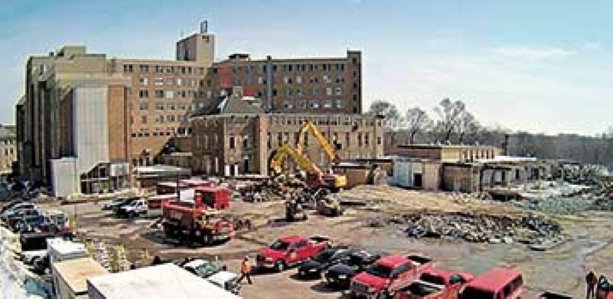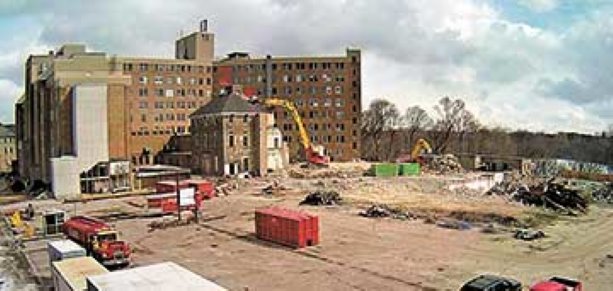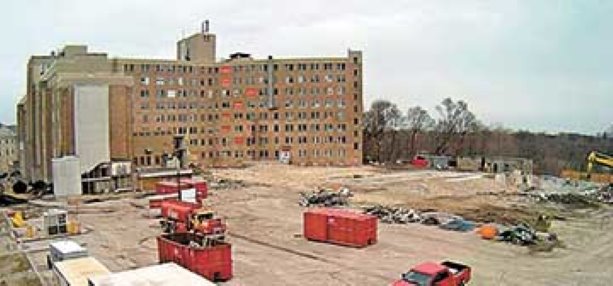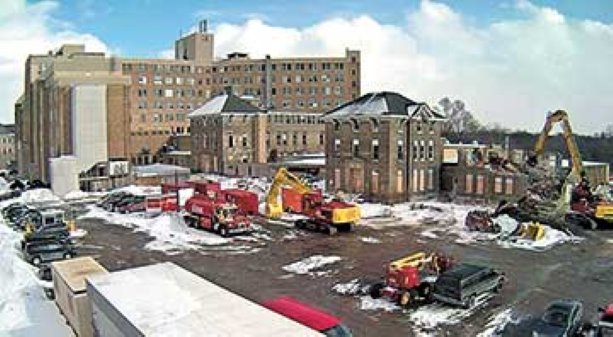By all accounts, it’s not your average demolition contract. First, there’s the nine-storey hospital with several wings and several other structures. There are also underground tunnels that link the hospital to other buildings on the street. And don’t forget the asbestos: it’s in everything from ceiling tiles and insulation for piping to vinyl tiles.
Even in an industry where no demolition is alike, the dismantling of London Health Sciences Centre’s former South Street campus stands out, says Paolo Provenzano, president of ProGreen Demolition Ltd., the Concord, Ont. company that is undertaking the first phase of the former hospital site’s demolition.
Because of its size the project has been divided into five areas. “Right now what we’re doing is the asbestos removal in the interior strip in the main hospital wings; and we’re doing some separations of some structures and also some demolition of structures,” says Provenzano in late March.
In one area, the amount of asbestos was so great that its removal required supplied air to keep workers safe. But the volume of asbestos does not come as a surprise: the project “was called out as an asbestos hazard remediation structural demolition,” he explains.
Pinchin Environmental Ltd. has been monitoring the hazardous material’s removal daily. The material is double-bagged and approved before it’s put into transport trailers to be disposed of at a licenced facility. “This is very labour intensive because of the magnitude of asbestos in the buildings,” Provenzano says. Currently, the company is running 75 workers on site to deal with its removal.
So far, work on the $9.5 million contract has been straightforward, he says. “We believe to be finished by the end of the year.”
They will be using high-reach demolition equipment (they have country’s tallest highest-reaching ultra-high demolition machine, he says) to demolish buildings from the top down.
Decisions on how to approach two 242-foot stacks on the hospital’s powerhouse have not yet been made, he says. “I don’t know if we’re going to be creative on this or not. We’re going to need approvals from the city if we do decide to do anything but as of right now there’s nothing in the works” about using blasting, he says.
Provenzano says materials like structural steel, copper and aluminum will be recycled. The building’s concrete foundations and brick rubble will be stockpiled, crushed and used for back fill at the site. The fill will be tested to ensure it meets environmental standards. Once the property is graded, topsoil will be added and hydroseeded.
For those interested in monitoring the project, photos taken every 15 minutes can be found on ProGreen’s website. The enhanced service reflects the company’s decision to use 52 cameras and remote, real time online video monitoring to conduct 24-hour surveillance. The approach has already come in handy.
“We’ve had about 15 people try to break in but all 15 got arrested,” Provenzano says.
The former hospital facility occupies about 18 acres directly south of London’s downtown core and about 10 individual buildings and several parking areas. Its demolition is taking place in two phases.
The first phase began late last year with hospital staff preparing the site for ProGreen to demolish.
Tim Dickson, senior project manager with AECON Canada Limited, which is administering the contract on behalf of the London Health Sciences Centre, says so far the main challenge has been weather. “We’re now hopefully getting out of the really intense winter conditions and moving into the spring and I suspect we’ll probably have equally intense summer conditions when we get there as well,” he said in late March.
Other than that, “the work has progressed extremely well,” he says.
The first phase tackles only development on the south side of the street from which the hospital derives its name. After it’s complete, the city resumes control of the property and will redevelop it.
AECON is working with the City of London and London Health Sciences to scope the work and prepare tender documents for the second phase, which will tackle buildings on the north side. Currently, it’s expected work will commence on the second phase in late 2016, Dickson says.
“It’s a smaller scope than phase A,” he says. “One would assume it would be done well within a year.”

1/3
ProGreen Demolitions Ltd.
2/3




Recent Comments
comments for this post are closed